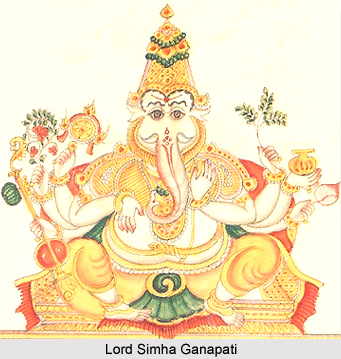 Simha Ganapati refers to the one riding a lion. It is one of the forms of Lord Ganesha. He is shown as mounting a lion as his divine vahana. The Lord is portrayed in white complexion. He carries the Veena (musical instrument), a bejeweled Kamandalu (pot for storing holy water), a sprig of the kalpataru tree, a bunch of flowers and a lotus. Simha Ganesha also holds a lion in one of His hands.
Simha Ganapati refers to the one riding a lion. It is one of the forms of Lord Ganesha. He is shown as mounting a lion as his divine vahana. The Lord is portrayed in white complexion. He carries the Veena (musical instrument), a bejeweled Kamandalu (pot for storing holy water), a sprig of the kalpataru tree, a bunch of flowers and a lotus. Simha Ganesha also holds a lion in one of His hands.
Some of the Mahapuranas and Upapuranas depict Lord Simha Ganapati with a composite face of a lion and an elephant and with eight arms. In this form, Lord Ganesha holds a Veena, a Vishnu chakra, a bejeweled Kamandalu, paddy, a lotus and a kalpalata. The main right hand displays the Varada Mudra and the main left hand is shown in the Abhaya Mudra posture. In this version, Simha Ganapati has the face of a lion with the trunk ofss an elephant. This form of the Lord has a striking similarity with the Narasimha avatar of Lord Vishnu. The devotees of Ganesha worship the Simha Ganapati form to attain blessing of the Lord, who will protect them from all fears and dangers.
Meditating on Simha Ganapati helps in gaining courage to confront various problems. Lord Ganesha, in this form, also removes all kinds of ill thoughts from the minds of His worshippers. This form of the Lord is prayed and worshipped in the Pandarpur Vitthal Temple in Maharashtra.
Simha Ganapati is venerated by the recitation of Simha Ganapati Mantra. The devotional religious hymn is mentioned below-
Veenam Kalapalatamarincha Varadam Dakshe Vidhatte Karaih
Vaame Tamarasam Cha Ratnakalasham Sanmanjareem Chaabhaye
Shundaa Dandala Sanmrigendra Vadanah Shankhendugowraha Shubhah
Deevyadravanibhamashuko Ganapatih Paayadapayatsa Nah.
This article is a stub. You may enrich it by adding more information to it. You can send your write-up at content@indianetzone.com




















